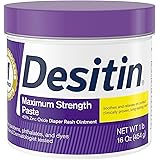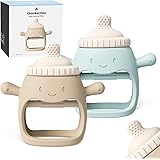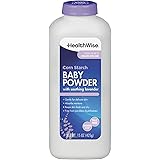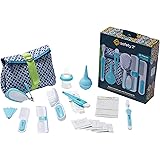Welcoming a newborn into your home brings immeasurable joy, yet it also ushers in a new world of responsibilities, sometimes feeling overwhelming. Many new parents find themselves wrestling with the simple act of bathing their tiny bundle, particularly when it comes to the delicate process of a baby head bath. The fear of getting water in their eyes, the slippery nature of a wet infant, or simply not knowing the right technique can make bath time a source of anxiety rather than a bonding experience. However, as the video above beautifully illustrates, an easy head bath for your baby is entirely achievable with a few simple, gentle steps.
This comprehensive guide aims to demystify the process, offering detailed insights and practical tips that complement the visual instructions you’ve just seen. We’ll explore everything from preparation to post-bath care, ensuring that washing your baby’s head becomes a calm and confident routine for both of you.
Why a Gentle Baby Head Bath is Essential
You might wonder why a specific focus on your baby’s head is so important during bath time. Unlike other parts of the body, a baby’s scalp can be prone to specific issues, such as cradle cap, a common condition characterized by scaly patches. Regular, gentle washing helps prevent buildup, maintain scalp hygiene, and keep your baby feeling fresh. Moreover, it’s an opportunity for sensory development, introducing your little one to the comforting sensation of warm water and your gentle touch.
Imagine if you went days without washing your hair; it wouldn’t feel very pleasant, right? Your baby also benefits from a clean scalp, which not only promotes healthy hair growth but also removes any sweat or residue that might accumulate. A well-executed washing baby’s head routine contributes significantly to their overall well-being and comfort.
Preparing for a Stress-Free Baby Head Bath
Before you even think about water, preparation is the cornerstone of an easy head bath. A calm environment and readily available supplies make all the difference. While the video quickly moves into the washing process, setting the stage beforehand helps avoid last-minute scrambling.
Gather Your Supplies:
- Mild Baby Shampoo: Choose a tear-free formula specifically designed for infants.
- Soft Washcloth or Sponge: Gentle on sensitive skin.
- Two Cups or Pitchers: One for clean water, one for rinsing.
- Hooded Baby Towel: To keep them warm immediately after the bath.
- Cotton Balls or Small Towel: Optional, for protecting ears.
- Fresh Diaper and Clothes: Ready for immediate changing.
- Warm Water: The ideal temperature is around 37°C (98.6°F) – always test it with your elbow or a bath thermometer.
Ensure your bathroom is warm and free of drafts. A chilled baby is often a fussy baby. Having everything within arm’s reach means you never have to leave your baby unattended, which is paramount for safety during a newborn bathing session. In contrast, trying to find items mid-bath can quickly turn a peaceful moment into a chaotic one.
Step-by-Step Guide to Washing Your Baby’s Head Gently
Now, let’s break down the actual process of the baby head bath, building upon the visual cues you might have observed. The key here is confidence in your movements and a gentle touch.
1. Positioning Your Baby Safely
Position is crucial for both safety and comfort. Many parents find it easiest to cradle their baby in one arm, supporting their neck and head, while the rest of their body is either in a baby tub or partially submerged in a larger tub. Some prefer to perform the head wash first, away from the main bath, to minimize exposure time. Imagine if your baby felt unsupported; they would instinctively tense up. Instead, a secure hold helps them relax.
2. Wetting the Hair with Care
Using a soft washcloth or a small cup, gently wet your baby’s hair. Avoid pouring water directly over their face. Instead, wet from the hairline back, or use the washcloth to dab water onto their scalp. If you’re concerned about water entering their eyes, you can use one hand to gently cup their forehead, forming a barrier, or place a clean, damp washcloth over their eyes for protection.
3. Applying Baby Shampoo
Dispense a tiny amount of tear-free baby shampoo onto your hand. Lather it gently between your palms before applying it to your baby’s scalp. Using your fingertips, gently massage the shampoo into their hair and scalp in small, circular motions. Be particularly gentle around the soft spots (fontanelles) on their head. This gentle massage isn’t just for cleaning; it’s also a soothing experience for your infant, contributing to positive infant hair care.
4. Rinsing Thoroughly and Gently
Rinsing is perhaps the most critical part of the baby head bath. Again, use a washcloth or a small cup of clean, warm water to rinse the shampoo out. Rinse from the front to the back, ensuring all shampoo residue is removed. Residual shampoo can irritate a baby’s sensitive scalp. If your baby is in a baby tub, you can carefully tip their head back slightly, ensuring water flows away from their face. In contrast, forceful rinsing can cause distress, so maintain a slow, steady stream.
5. Drying with a Soft Touch
Once rinsed, immediately wrap your baby in a warm, hooded towel. Gently pat their head dry, rather than rubbing. Pay attention to any folds in the skin and behind the ears to prevent moisture buildup. Keeping them warm and dry quickly prevents chills and completes the positive experience of their baby bath time.
Addressing Common Challenges During the Head Bath
Even with the best intentions, challenges can arise during a washing baby’s head routine. Knowing how to troubleshoot can turn a potential hurdle into a minor bump.
1. My Baby Cries During Bath Time!
A fussy baby is a common concern. Firstly, check the water temperature and room warmth. Is it too hot, too cold, or is the room drafty? Sometimes, babies simply don’t like the sensation of water on their head. Try talking to them in a soothing voice, singing a soft song, or even having a partner distract them with a toy. A small, familiar toy can sometimes shift their focus from the discomfort to play. Remember, a calm parent often leads to a calm baby. Conversely, a stressed parent can inadvertently transfer that anxiety to the infant.
2. What About Cradle Cap?
Cradle cap, those scaly patches on a baby’s scalp, is very common. During the baby head bath, you can gently massage a small amount of baby oil (like mineral oil or olive oil) onto the affected areas about 15-30 minutes before washing. This helps soften the scales. During the bath, use a soft baby brush or a dedicated cradle cap brush to gently loosen the scales while shampooing. Rinse thoroughly. Do not pick or force the scales off, as this can irritate the skin. Regular, gentle cleaning with a mild baby shampoo is often enough to manage it.
3. Getting Water in Eyes or Ears
The fear of water in delicate areas is real. As mentioned, cupping their forehead with your hand or using a damp washcloth over their eyes can create a protective barrier. For ears, cotton balls can be loosely placed in the outer ear canal (never push them deep inside!) to absorb any splashes. More importantly, using a controlled pour with a small cup or a gentle squeeze from a washcloth significantly reduces the risk. An easy head bath prioritizes careful water application.
Post-Head Bath Care: Beyond the Rinse
Once the baby head bath is complete, the care doesn’t stop. Immediate post-bath care is just as important for your baby’s comfort and hygiene. After gently drying their hair and scalp, consider applying a baby-friendly moisturizer if their skin seems dry. This is particularly useful in preventing dryness that can sometimes contribute to cradle cap or general skin irritation. Brush their hair gently with a soft baby brush, especially if they have longer locks, to prevent tangles.
Dress your baby promptly in a fresh diaper and comfortable clothes to maintain their body temperature. This final step helps reinforce a positive association with bath time. A consistent, warm, and secure routine will make the baby head bath a cherished part of your daily or weekly infant care, promoting a lifetime of good hygiene habits.











